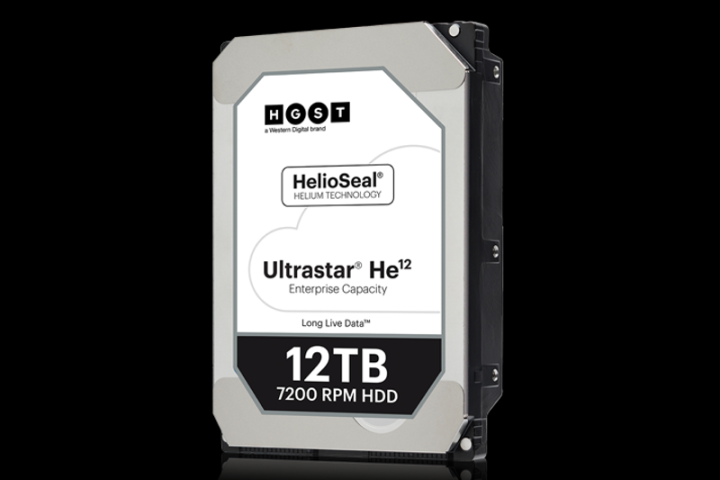
As a brief explanation, hard drives resemble enclosed record players where a needle/head reads the information from a spinning disc. In this case, data is stored on a magnetic disc, which typically has a physical limit to its storage amount. To increase the overall capacity of a hard drive, manufacturers stuff more spinning discs and readers into the drive. But all that high-speed spinning causes friction due to the “weight” of air, limiting the number of discs used in a 3.5-inch form factor.
But because helium is a lightweight gas (1/7 the density of air), there is less resistance as hard drive platters spin round and round like a record (baby). So not only can hard-drive makers cram in more magnetic platters, the motors spinning those platters meet less resistance, consuming less energy than the standard air-filled hard drive. The arms holding the read/write heads suffer less turbulence, too.
That said, Western Digital managed to cram eight platters into its new helium-filled hard drive, up from seven used in previous Ultrastar models. It’s a “world’s first,” indicating that each spinning magnetic platter can hold approximately 1.5TB of data. The platters are thinner than what’s found in air-filled drives, too, while “maintaining a stable recording interface.”
Here are the hardware specs of the new Ultrastar He12 drives:
| Form factor: | 3.5 inch |
| Number of platters: | 8 |
| Maximum areal density: | 864Gbits per square inch |
| Sector sizes (SATA): | 4Kn – 4,096 512e – 512 |
| Sector sizes (SAS): | 4Kn – 4096, 4112, 4160, 4224 512e – 512, 520, 528 |
| Data buffer: | 256MB |
| Rotational speed: | 7,200RPM |
| Latency average: | 4.16ms |
| Interface transfer rate: | 600MB/s (SATA) 1,200MB/s (SAS) |
| Sustained transfer rate: | 255MB/s (typical) |
| Seek time: | 8.0ms read, 8.6ms write |
| Power rating (SATA): | 5.3 watts idle, 7.2 watts operating |
| Power rating (SAS): | 6.1 watts idle, 9.8 watts operating |
| MTBF: | 2.5 million |
| Dimensions: | 1.02 (H) x 4 (W) x 5.78 (D) inches |
| Weight: | 1.45 pounds |
Now here are the differences between all four variants:
| Model | Interface Type |
| HUH721212ALE60y | 512e SATA 3 (6Gbps) |
| HUH721212ALN60y | 4Kn SATA 3 (6Gbps) |
| HUH721212AL420y | 4Kn SAS (12Gbps) |
| HUH721212AL520y | 512e SAS (12Gbps) |
Outside the 12TB storage capacity, some of the highlights include Instant Secure Erase (ISE) and Self-Encrypting Drive (SED) options, 24×7 continuous availability, and an annual fail rate of 0.35 percent. All four models ship with a five-year limited warranty.
“It encompasses a low-power design without compromising performance, which helps reduce overall cost of ownership,” the company said on Wednesday. “The Ultrastar He12 HDD is perfect for any application that requires massive amounts of cost-effective storage.”
Unfortunately, Western Digital did not release any pricing information, as the helium-filled drives are shipping to distributors now. Eventually they will make their way onto Amazon, Newegg, and other online retails and sit alongside Western Digital’s other Ultrastar products.


